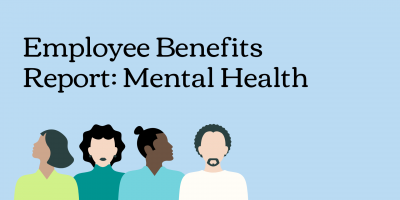
Employee Benefits Report: Mental Health
Amid rising chaos, nearly half of all Americans face mental health challenges—how are businesses stepping up to meet the growing demand for support?

In my experience as an HR tech company founder and former CFO (three times) and COO (twice), I’ve observed several common behaviors and actions that signify a toxic work environment.
One of the most prevalent issues is a lack of effective communication.
When employees feel that information is withheld or that their voices are not heard, it can lead to confusion and frustration.
Micromanagement is another concerning behavior that often contributes to toxicity. Overbearing control and a lack of trust in employees can stifle creativity and autonomy, causing dissatisfaction among the workforce.
Additionally, any form of bullying, discrimination, or harassment is a clear indication of a toxic work environment. Such behaviors, whether they manifest as verbal abuse, intimidation, or offensive comments, can be deeply harmful to employees’ well-being and job satisfaction.
Unrealistic expectations and constantly shifting priorities are also typical in toxic workplaces, leading to stress and burnout.
Lastly, the failure to recognize and reward employees for their efforts can leave them feeling undervalued and demotivated.

Employees facing a toxic work environment often find themselves in challenging situations, but there are constructive steps they can take to address the issue.
Documenting incidents is a crucial first step, as it provides a clear record of toxic behaviors, including dates, times, and individuals involved. This documentation can be a valuable resource should they need to escalate the issue.
Seeking support from colleagues, friends, or mentors can provide emotional assistance and guidance during difficult times.
Additionally, employees should consider initiating an open and honest conversation with their immediate supervisor or HR department to address their concerns. Many companies offer resources such as Employee Assistance Programs (EAPs) or counseling services to help employees cope with workplace stress and toxicity.
Others are beginning to offer health and wellness stipends that can be used to support each employee’s unique mental health needs.
Lastly, employees should familiarize themselves with labor laws and company policies related to harassment and discrimination to ensure they understand their rights and avenues for recourse.

As a leader and CEO, I believe that leaders and management hold a significant responsibility in shaping the work environment and mitigating toxicity.
Leading by example is paramount.
Demonstrating respectful and inclusive behavior sets the tone for professionalism and ethical conduct throughout an organization.
Establishing – and actively using – clear communication channels and encouraging open, transparent dialogue helps address concerns proactively.
Promoting a healthy work-life balance demonstrates a commitment to employee well-being and can prevent burnout and stress. This means ensuring your employees feel safe enough to take their PTO or a day off for mental health (or other reasons) when needed.
It also means allowing them to set boundaries so they can log off after work and disconnect on the weekends without having to check email and instead be fully present in their personal lives.
You want to create a space in which they feel truly supported so they can always bring their best selves to work.
Offering training on diversity, inclusion, and conflict resolution to employees and managers can foster a more inclusive and understanding workplace. Consistently enforcing anti-harassment and anti-discrimination policies is essential, and taking swift action when violations occur demonstrates commitment to a safe and respectful workplace.
Seeking regular feedback from employees through surveys or anonymous channels helps identify areas of concern, and investing in employee development and mentorship programs can create a positive work culture that discourages toxic behaviors.
When toxic behavior is identified, addressing it promptly and fairly through appropriate disciplinary measures is crucial to maintaining a healthy work environment.

Identifying and addressing toxicity in the workplace requires a collective effort from both employees and leadership.
By fostering a culture of respect, communication, and support, organizations can mitigate toxic behaviors and create a more positive and productive work environment.

Founder & CEO of Compt
Browse our curated list of vendors to find the best solution for your needs.
Subscribe to our newsletter for the latest trends, expert tips, and workplace insights!

Amid rising chaos, nearly half of all Americans face mental health challenges—how are businesses stepping up to meet the growing demand for support?

Gain a comprehensive understanding of current trends, challenges, and innovative approaches to support mental well-being in today’s fast-paced work environments.

Postpartum and peripartum depression (PPD) is the most common mental disorder experienced after childbirth. So, what happens while you’re in the midst of it or recovering, and you’re due to return to work?

To say that ADHD in the workplace is intricate would be an understatement. Explore what ADHD means for all involved parties and the best tools and strategies for ADHD in the workplace.
Shortlister Connect is a tool specifically designed to be utilized by the HR and Procurement/Sourcing teams within mid-size, large and jumbo employers. Shortlister Connect allows these teams to efficiently research & identify their optimal vendor partners, track existing vendor relationships & performance and “connect” with other employers to share successes and vendor experiences.
If you are not on the HR or Procurement/Sourcing team within an employer with over 200 employees, you will not be granted access to Connect. Examples of individuals that would not be granted access include, but are not limited to: vendors, students, practitioners, researchers, other non-employers or anyone that is unwilling to identify themselves will not pass our vetting criteria. If you are a consultant, Shortlister offers a specialized product for consultants, called Shortlister Select. You can email Tom Ciccotti at tciccotti@myshortlister.com to learn more about Shortlister Select.
***Shortlister retains the exclusive right to grant or deny access to any party to ensure the privacy of the vendors in our system.
Please login with your LinkedIn Credentials
Used by most of the top employee benefits consultants in the US, Shortlister is where you can find, research and select HR and benefits vendors for your clients.
Shortlister helps you reach your ideal prospects. Claim your free account to control your message and receive employer, consultant and health plan leads.